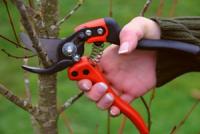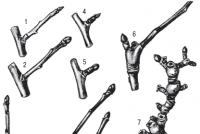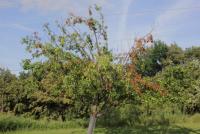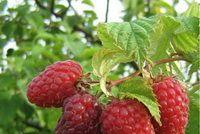Why dries 5 year old apple tree. Why do trees die? How to save fruit trees
Young garden. Beauty and pride of every summer resident. The owner does not rejoice in the young trees in their spring greenery. The garden is growing ... But in the outer part of the crown of an apple, pear, apricot, and other garden crops, dry tips of young shoots appeared. Drying the tops of the shoots spread from top to bottom. For individual trees, the tops are completely bare. And there comes a time when the owner realizes that the garden is sick with a dead-top. The disease affects the longevity of the garden and its fruiting. If a separate tree fell ill, then the reason may be in violation of agricultural technology. If the disease progresses and manifests itself in several trees, the cause may be infection of their diseases and damage by pests. It is necessary to understand the causes and take the necessary preventive and therapeutic measures.
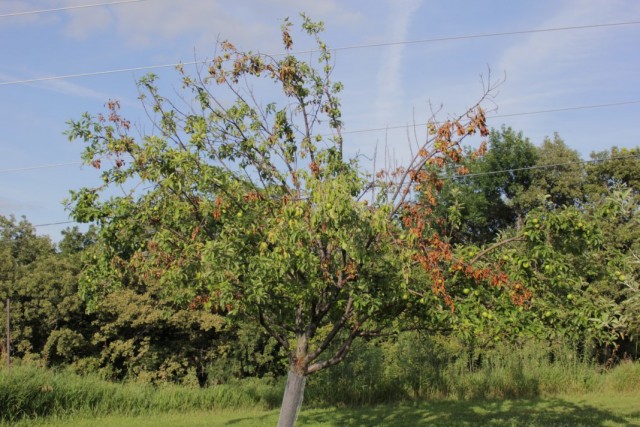
How to determine the causes of dry top trees?
The main manifestation of dryness is the drying of young shoots and branches of the upper tier of the crown. Most often, the dryness is manifested in spring, sometimes in the second half of summer. The reasons for the occurrence of a dry top depend on many reasons. They can be caused by a violation of agrotechnical (planting and care) or agrochemical (nutrition) culture requirements, disease damage (monilial, bacterial burns, bacterial cancer) or pests (larvae of the Maypole, bark beetle, etc.).
With properly planted tree crops, the tops of the trees will dry out last. In this case, the desiccation of young shoots and perennial branches usually begins with the death of the lower branches, withering of the leaf mass, changing its color, shedding flowers, and only then begins the immediate desiccation of the shoot itself.
1. Violation of agrotechnical requirements
For a garden, air- and water-permeable soils are necessary, having a uniform structure and sufficiently provided with nutrients throughout the profile. Trees will not live long and will form a very poor harvest on dense clay soils, with close bedding under a fertile layer of rubble, sand, and construction debris.
For the garden, high groundwater is necessary, not closer than 1.6 m to the soil surface. Trees with taproot, penetrating deep into the soil up to 1.5-2.0 meters or more, are especially sensitive to groundwater of stagnant / stagnant waters. At high standing of ground waters the air mode is broken. Oxygen practically does not flow to the suction roots, the root system suffocates, and water does not flow to the upper part of the crown and the tree dies.
The acidity and salinity of the soil have a negative effect on the growth and development of trees. They develop poorly and after 5-8 years or immediately die.
Improper planting of seedlings: a violation of the location of the root collar, the location of the vaccine, the absence of drainage (if necessary), a narrow planting pit in which the roots are intertwined, with bends, etc.
Irregular watering. Sometimes novice gardeners pereuvlazhnyayu landing, considering that dry branches and shoots - a signal of lack of water.
How to prevent and fight?
Bookmark the garden does not tolerate haste. Quickly (hastily) the planted garden quickly perishes. In order for the garden to bear fruit and be healthy for the entire period allotted to it, it is necessary to carefully comply with the requirements of agricultural engineering.
A fruit garden is always laid on fertile, moisture- and air-permeable soils with a neutral reaction to acidity, the pH of which should be 6.5-7.2. Groundwater deposition is optimal 2.0-2.5 m from the soil surface. If the site does not meet these requirements:
Dilute the soil and bring its acidity to optimum with lime or dolomite flour.
With the close occurrence of groundwater, the tip perishes first, and then the whole tree. In such areas, you can plant trees on high ridges, and cut drainage ditches between the rows. If the garden consists of several trees, then in the planting pits need to lay a high drainage of 20-25 cm, 2/3 of the pit filled with prepared soil mixture. Lay a square or round barrier on the soil and cover it with the rest of the prepared soil mixture. The root system of the seedling should be located in the upper part of the planting pit and the bulk hill so that the root collar does not become bare, and the grafting site is above the ground. Bare root collar is treated with garden pitch or clay mixture and covered with soil. After watering, the soil must be mulched 5-6 cm with a layer of small mulch.
For areas with high groundwater, it is better to use columnar varieties or seedlings on dwarf and semi-dwarf rootstocks. This will save the root system of horticultural crops from soaking when water stagnates on dense soils or high groundwater location.

If the soil passes moisture very quickly (sandy, peaty), then dry top may be associated with a lack of moisture in winter. The root system of the fruit tree can dry out at temperature differences associated with the transition from thaw to frost. Gardens located on such soils require abundant underwinter irrigation. In this case, the root system will be when the soil freezes in the ice shell, which will protect it from drying out.
If moles, mice and other large soil pests start in the garden, all measures should be taken to expel them. Mole passes, mouse gnawing of the root system also cause the death of crops.
2. Eating Disorder
If all agrotechnical requirements are met, then the cause of the development of dry top may be a malnutrition of fruit trees. Lack or violation of the ratio of basic nutrients and other macronutrients and microelements is manifested not only by dryness, but also by a decrease in the quality of fruits. Especially carefully it is necessary to track the nutritional regime when laying a garden on lime, gray forest, marshy, sandy, sod-podzolic, calcareous and ameliorated soils, developed peatlands, etc.
Macro and trace elements enter the plants through the root system. With a nutritional deficiency, some of the elements are redistributed between the organs of the plant. There is an outflow from old leaves to the fruit and younger organs. But there are trace elements that are not capable of redistribution. These include boron, zinc, copper. Their lack or violation of the ratio with the main nutrients causes the dieback of fruit crops.
Boron deficiency
The lack of boron is manifested in stopping the development of upper leaves. At the ends of the shoots the leaves curl, shrink and fall off. With a large deficit of boron, the upper branches begin to dry out, and corky ulcerations appear in the fruit, the fruit taste acquires a characteristic bitter taste. With sufficient availability of fruit crops with phosphorus and calcium, it is necessary to add boron in the form of root and foliar top dressings, especially in dry years. However, high doses of boron cause general tree toxicosis. To remove the "poisoning" with boron, it is necessary to feed the plants with phosphorus and calcium. It is best to apply boron fertilizers together with phosphate nutrition when feeding with full fertilizer. Remember, in dry years and with a lack of moisture, boron deficiency in plant organs increases.
Copper deficiency
Copper is especially needed fruit crops in the period of growth and flowering. If during this period, the rapid growth of lateral shoots begins, on the leaf blades between the veins chloro-brightening appears, and the desiccation spreads from the tips of the shoots down - it means the trees become tough due to lack of copper. In order to prevent the upper shoots from drying out, fertilizer containing copper should be added to the top dressing. In addition to active participation in all metabolic processes, copper preparations contribute to increased frost, heat and drought tolerance. On the soil, the availability of copper to plants decreases, as its enhanced absorption by soil particles takes place. In this case, in early spring, before bud break, it is necessary to process fruit trees with copper sulphate (1%), Bordeaux mixture (3%) or other copper-containing preparations and feed them with copper fertilizers or a complex set of trace elements during the growing season. If there is no copper-containing fertilizer or a set of trace elements, you can repeat the treatment Bordeaux fluid (1%) on the green cone and after flowering. During the growing season, you can feed ash.
Lack of zinc
The lack of zinc is clearly manifested at the beginning by the formation of rosettes (rosette) of underdeveloped shoots and leaves, and later begins dieback. Especially quickly react to the lack of zinc in apple and pear. Exacerbates the lack of zinc, the introduction of higher doses of phosphate fertilizers and acidity of the soil. Particular attention should be paid to the main fertilizer and fertilizing on chernozem, chestnut soils, brown and strongly podzolic low-oxidized. During the growing season, fertilizing with micronutrients and ashes is obligatory. Good results provide podzimnie crops sideratov.
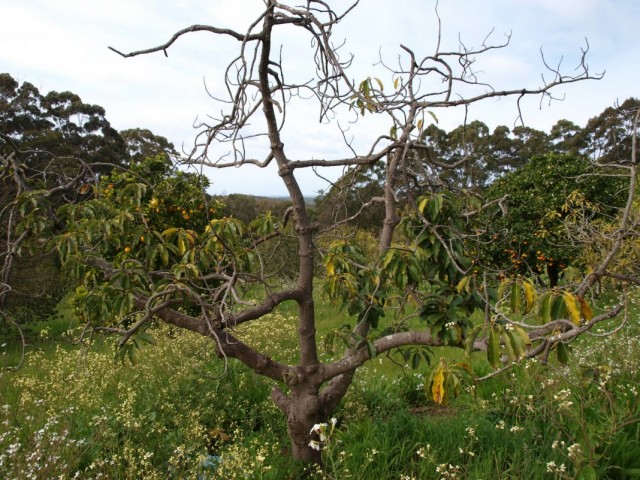
3. Vertex caused by pests
The dry top of fruit crops, especially at a young age, can be caused by the appearance of dangerous pests, both soil and living on young vegetative sprouts of the crown (larvae of the cockchafer, aphid, ants, bark beetle, wood caterpillar and others). 4-5 year old young trees of mulberry, quince, apple, plum, pear are especially often damaged. Every spring and autumn, young trees are subject to thorough inspection. Most often, the damaged bark is a breeding ground and wintering places for various pests. If cracks have appeared in the cortex, they should be repaired, all damages should be disinfected, the trunk and skeletal branches should be gouged with lime mortar or special garden paint. The larvae of the May beetle are especially harmful to young trees. Literally 2-3 larvae can destroy a young tree, damaging its root system. Carefully inspect the tops of the young shoots. If dry leaves appear on them in the second half of the summer, this may be a sign of the appearance of corundum. The butterfly of a wood plant lays eggs on young sprouts at the base of leaf petioles. The hatching caterpillar easily takes root in the young shoot (a small hole is visible at the point of introduction, sometimes on certain types of crops, a floating gum) and begins to feed heavily. Having damaged young wood, it creeps into deeper layers, and the damaged young twig dries out. The caterpillar winters in the wood passages and, in the spring, moves to the surface through the passages done. Through inlets caterpillar throws out its excrement. The same signs leave the caterpillars of the eastern moth, glass cases.
Protective activities
To destroy pests that cause the dry top of the trees with their harmful activity, remove the affected branches with the seizure of 15–20 cm of healthy wood. In the holes made in the bark of the skeletal branches and the central trunk by bark beetle, BI-58, confidor, aktar, karbofos and other insecticides are first injected with wood, then poured with garden pitch or liquid cement, take other measures of protection against pests. During the growing season, all activities are carried out on the treatment of horticultural crops from pests, using mainly bioinsecticidal preparations.
4. Durability caused by diseases
Sometimes dry top is associated with fungal-bacterial damage of fruit crops. Shrunken shoots of the upper crown often indicate the onset of infectious diseases (moniliosis and bacterial burns, powdery mildew, bacterial cancer, and others). Of fungal diseases, the tree tops of moniliosis, bacterial burn and powdery mildew dry out. Moniliasis most often affects bone fruit: apricots, perches, peaches, cherries. Appearance - blackened tops of shoots and branches, brown flowers. The affected branches are burned as if by fire. And the trees get sick literally in a matter of hours. After the affected flowers fall off, the diseased branches become covered with numerous small points of the protruding gum. The single flowers that remain alive form an ugly, scabbed, low-grade fruit.
The mycelium of powdery mildew, as it were, sprinkles young shoots and leaves. If you leave the tree unattended, the scattering disputes will start to hit the neighboring trees, and their young shoots will start to shrink.
Bacterial damage that causes branches to shrink is manifested as a bacterial cancer or a bacterial burn. By affecting the heart of the wood, bacterial cancer prevents the entry of water and nutrients to the upper branches. The last dry up. Bacterial burn caused by a bacterial infection. Consider that a bacterial burn is a quarantine disease. For 1-3 years, the affected trees die.
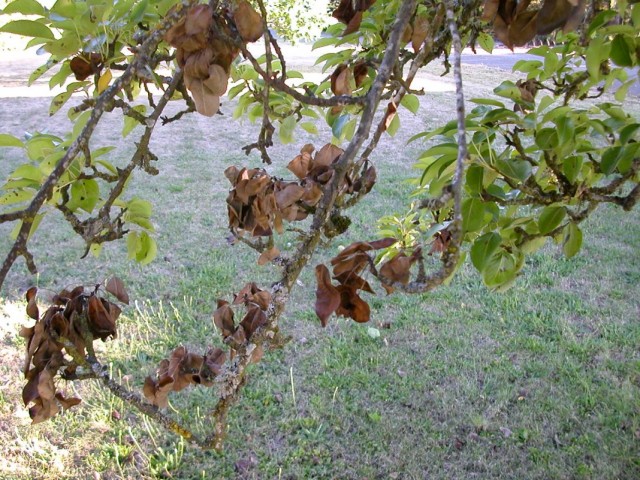
Protective activities
When laying the garden using varieties of garden crops that are resistant to fungal-bacterial diseases.
In infected gardens it is very difficult to destroy the sources of infection. Therefore, it is easier to prevent it by carrying out all preventive measures of protection in a timely manner than to fight the infection, especially in early-ripening cultures. Prevention is an annual early spring and late autumn garden treatment with chemicals: Short, Horus, Topaz, Ordan, Ridomil and others approved for use on fruit crops. Recommended spraying before blooming buds 3% Bordeaux liquid or 1% solution of copper sulphate. On the green cone and after flowering - 1% solution of Bordeaux mixture, which simultaneously serves as a top dressing. During the growing season, the garden is systematically treated with biofungicides in accordance with the recommendations. The impaired integrity of the bark (cracks), hollows and other damage must be cleaned and sealed with garden pitch, paint, cement, any other material in order to prevent ingress of hibernating fungal spores and bacteria. The most successful treatment of a bacterial burn is the use of antibiotics.
If preventive measures did not help and the trees got sick, you need to prune the affected branches and burn them. Trees are immediately treated with appropriate preparations and fed to increase resistance to further infection. To continue the whole growing season of treating trees from a fungal-bacterial lesion. In the spring and autumn, treat the soil within the crown with a 4% solution of urea.
"Article from the site Botanichka.ru.
It is hard to imagine that an apple tree does not grow on a piece of land, even tiny. If it is a fruit-friendly area, apple orchards become sources of income. But wherever this beautiful tree grows, diseases can overtake it. Why do leaves grow black and dry in the apple tree, why the tree dries and what to do - questions that are answered.
Prevention
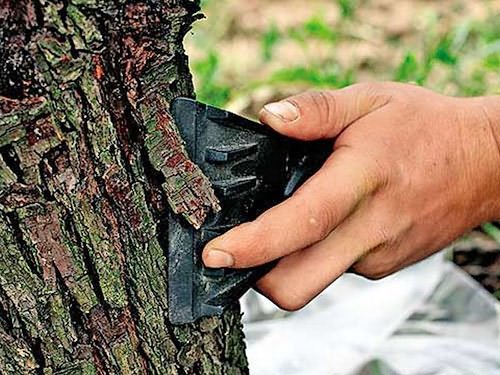
The garden only attracts glances, causes admiration when he is healthy. And the fact that it is easier to prevent the disease than to cure it applies not only to the person, but also to his green friends. From the very beginning of cultivation of an apple tree, it is necessary to control its development.
When buying a seedling, you should make sure that the root system is well developed and there are no mold spots on the roots, the surface color is uniform. The vaccination site is noticeable. The stem has a uniform color, the bark is not damaged. Harvesting the leaves of fallen trees in the fall will prevent the spread of spores and other infections; it is best to burn the autumn garden leaves and then use the ashes as fertilizer.
Pruning and crown formation should be performed only with a disinfected instrument, and the wounds should be immediately closed from the penetration of contagion. A photo of the disease of apple leaves and their treatment will show the danger of non-compliance with hygienic requirements. In the spring, two treatments with fungicides should be carried out when the kidneys are swelling and on the green cone. For mature trees need timely feeding, mulching pristvolnogo circle.
The tree will remain healthy only with proper care and will delight the decoration and harvest. Strict adherence to agricultural technology pledge of a healthy garden.
If all activities are completed, the apple tree can get sick in rare, especially unfavorable years. If you know the signs of the disease, during the inspection you can understand the reason for the yellowing of the foliage on the apple tree.
Apple Diseases
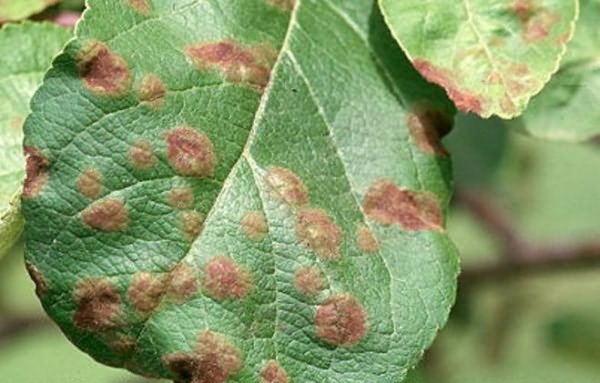 The apple tree is nourished from the roots and leaves. Therefore, the disease of any part of the tree, if not treated, will lead to death. Why an apple tree dries and what can be done can be determined on the spot. There are various diseases that are transmitted:
The apple tree is nourished from the roots and leaves. Therefore, the disease of any part of the tree, if not treated, will lead to death. Why an apple tree dries and what can be done can be determined on the spot. There are various diseases that are transmitted:
- disputes;
- bacteria;
- viruses.
Scab
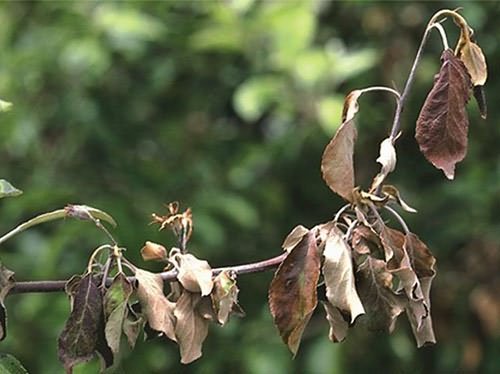 In the spring after blooming young leaves, oily specks on the young foliage will become noticeable. This is a scab on an apple tree. Over time, spots on top are covered with velvet bloom, then the whole plate becomes brown. That is why the apple trees not only turn black and the leaves dry at the height of summer, but the fruits are also affected by the disease and become unfit for food.
In the spring after blooming young leaves, oily specks on the young foliage will become noticeable. This is a scab on an apple tree. Over time, spots on top are covered with velvet bloom, then the whole plate becomes brown. That is why the apple trees not only turn black and the leaves dry at the height of summer, but the fruits are also affected by the disease and become unfit for food.
 Scab is a fungal disease. Its spores overwinter on last year's foliage and are introduced into the plant along the green cone, from the moment young leaves appear. The condition for the introduction of a leaf becomes slow disclosure, and warm rainy weather. In such conditions, the embedded spores germinate and create a mycelium. Scab often affects old trees with a thick, poorly blown crown. Having developed, the disease first destroys the leaves, they turn black and fall off. Fruits are ugly or fall off after tying.
Scab is a fungal disease. Its spores overwinter on last year's foliage and are introduced into the plant along the green cone, from the moment young leaves appear. The condition for the introduction of a leaf becomes slow disclosure, and warm rainy weather. In such conditions, the embedded spores germinate and create a mycelium. Scab often affects old trees with a thick, poorly blown crown. Having developed, the disease first destroys the leaves, they turn black and fall off. Fruits are ugly or fall off after tying.
The fight against fungal diseases is in compliance with agricultural technology, repeated spraying of fungicides based on copper or their substitutes. All treatments are stopped 3 weeks before harvest.
Rust
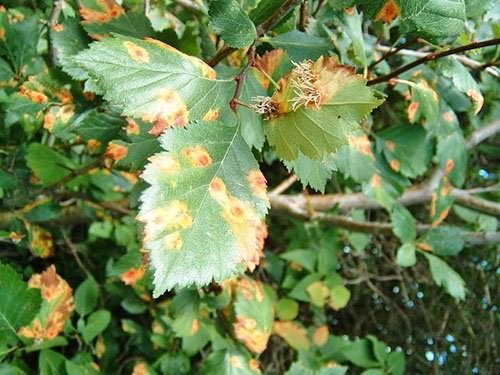 Another major disease of fungal nature is rust. This disease manifests itself after the apple tree blooms. Orange spots appear on the leaves of the tree on the top of the plate. On the spots there are black dots, under them are spore sacs that open and shoot spores. The bottom of the sheet also gets a yellow spot in this place. In the future, the disease progresses, as seen in the photo. Diseases of apple leaves and their treatment is a process that requires patience.
Another major disease of fungal nature is rust. This disease manifests itself after the apple tree blooms. Orange spots appear on the leaves of the tree on the top of the plate. On the spots there are black dots, under them are spore sacs that open and shoot spores. The bottom of the sheet also gets a yellow spot in this place. In the future, the disease progresses, as seen in the photo. Diseases of apple leaves and their treatment is a process that requires patience.
In addition to leaves, rust in a state of neglect affects the fruits and branches of the tree. Initially, the fungus develops on a juniper, and later, after wintering on plant residues, it falls on a leaf of a tree.
Therefore, the juniper in the garden must be treated for fungal diseases, often even without visible signs of rust.
 Rust can cause yellowing of apple foliage. It also leads to fruit fall and cracking of the bark on the trunk. At the first signs of rust, it begins to fight. Immediately remove all infected leaves, shoots, fruits. The branches are cut a few centimeters below the point of infection. Spraying is carried out with one of the following preparations:
Rust can cause yellowing of apple foliage. It also leads to fruit fall and cracking of the bark on the trunk. At the first signs of rust, it begins to fight. Immediately remove all infected leaves, shoots, fruits. The branches are cut a few centimeters below the point of infection. Spraying is carried out with one of the following preparations:
- on the basis of copper - cuproxate, chlorine oxide, vitriol copper 1%;
- solution "zineb" 0.4%;
- Topaz, Vectra.
Treatments are repeated at intervals of 2 weeks until the end of the season.
In order to prevent this formidable, and difficult-to-remove, fungal disease, several rules should be observed:
- do not allow the neighborhood of conifers and fruit trees in the immediate vicinity;
- in early spring, before the start of sap flow, find the affected places, clean them up to healthy wood, process 5 grams of half cup of boiling water with a strong solution of copper sulphate (5%);
- smear with garden pitch or special putty, after repeating the treatment with fungicides for prophylaxis.
You rich crops and a healthy garden! Read why the leaves of the apple tree turn yellow!
Video about protecting apple from pests and diseases
glav-dacha.ru
So trouble came - young apple trees dried up ...
Alexey
This is not a pest or groundwater.
1. This may be a problem with the roots. Here karbofos not help. Apple trees began to grow due to nutrients accumulated in the bark and wood, and then they bent, because the roots do not supply more nutrition. I would dig a little to the side and look at the condition of the roots. If the roots really bent, one could try to ring the stem above the ground and cover it with a thick layer of fertile land, water it and try to transfer it to its own roots.
2. It may be a wood fungus. It is necessary to cut the branch and see what state it is inside. But there is no effective means of wood fungus, for example, “Black Fungus”.
Alekseyka
They fell asleep, not dried up. This year 3 pears have swelled up in me, and they have not started growing. Winter is snowy, then it rains, it rains every day. Now 0.5 bayonet is water. I make a drainage with a depth of 0.5 meters. I hope to revive, if not this, then next spring.
Http://sad6sotok.ru/spread- apple-pears. html type
Marfa Ivanovna
oh I sympathize with you .. and the branches do not darken? I bought apple trees for southern latitudes, and it also began, and then the cancer-rejection vaccination (read) went. .
maybe your roots are flooded ...
Marina
Try zircon spray once a week - from stress, and you can water under the root
Lyubov Danilova
If you feel sorry for deleting and planting new ones, I advise you to leave them until next year. I also had because of the frosty winter, and the apple tree was not frost resistant. On the next year, some branches were dry. They removed them, and the apple tree is alive again. Each year, then removed part of the branches. Now it is a pity to look at her, although it bears some fruit. So if non-frost resistant variety, it is better to remove it immediately.
Larisa
Do not rush to remove them. I, too, had this experience more than once with cherries, pears and some decorative ones, namely with young saplings. If the branches and trunk are alive, not blackened, then all is not lost. Of course, to take action you need to know the reason. It is hardly a disease or pest - the trees have just moved away from the winter. And, of course, this is not from trimming. If the reason is not in "high water", can frost? Frosts are "stripes" and "spots." The plant growing in 2 meters is not touched, and it is this - beaten. Last year, my Manchurian nut, actinidia and filbert were so “frozen to death”. All of them are located in one corner of the site. And I think you have a local microclimate. In one night, all the blooming leaves turned black. But then the new ones blossomed. This year everything is fine. Do not rape the plants, watch them first.
Vera Kstenina (Tyuleneva)
And so begins the new cycle, the groundwater rises and the whole reason
Nastasya Filippovna
Tatyana Pavlova
Instead of a root, I recommend Energen - it stimulates the growth of a plant very much!
Alex
I think one hundred percent - high groundwater. Do not hope for the well: we had the same in the garden - a well three meters from the apple tree, 6 meters deep, and the water in it stands a meter below the ground level. And the roots of the nearest apple are all wet. You dig a shovel - water oozes out. He made a grand drain from the apple. Just in case, read this - http://lilygold.ru/view_post.php?id=31
Maybe it fits.
Filipych
I read everywhere here ::: at close groundwater, people plant on the mounds !!! But do these mounds save ??? Well, then .. if you think well !! ! Well, what kind of a hill should be erected so that the root system below did not pass to the groundwater, then that and the whole fit into this knoll! ? At least a meter, the elevation probably should be - this is at first when the tree is still relatively young !!! And you have obviously close groundwater and no well will "pull them away" !!! I don’t know of course what to do, but I would wait for will come out of it !! It will always have time to remove it !! But in principle, in life, every planted and adopted sapling is pitiful - how many souls are invested !!!
Tanya Timoshevskaya
Groundwater, probably, is nothing to do with, we have 60 meters in the area to them, but three young pears suffered in the same way. She fertilized with a humate, sprinkled Aktellik and epin, one during the week threw out new leaves, but two columnar ones still stand without leaves, although they are alive. I don’t know what to do, maybe I can give more fertilizers?
Dries a young apple tree. Why?
Lelya Casanova
Cytosporosis, if the leaves are not silvery. Cut dried branches to 50 cm below the border of drying, sanitize the place of the cut with copper sulphate 30g per 1l of water, cover them with garden pitch or oil paint. Whitewash in September and March to a height of at least 1m. Raspberries and apple trees have different diseases, so raspberries have nothing to do with it.
Do not lie! There will be grief ...
Ecology?
Valentina Timofeeva
maybe in winter a sunburn got, or got frozen, I, too, dried up so gradually
Angela Goryacheva
Black apple crab?
olga
there can be many reasons. One of them - a mole went under its roots in search of worms and its roots hung in the air.
The apple tree has dried up, and processes have gone below. get out of them the same good apple tree as it was?
Avyzapisalis ....
Leave a couple of branches from the overgrowth (if both are taken, then remove one, then), remove the rest and inoculate (budding) the desired variety in July. Thanks to a powerful root system, this tree will grow many times faster than a new sapling.
uncle Pechkin Bugaga
Stepan Kapustin
This apple tree didn't grow for you
Igor Velikanov
Not a fact .... if it was vaccinated, and this is more often the case, then the vaccine has dried up, and the dick grows from the roots ....
Igor Fedortsov
It is better to plant a sprig with a good apple
Alexander Belyaev
Hardly. If the twigs have gone from the root, they will not be such as they have gone from the stock, winter-hardy but not commodity farm
HELENA
Root growth is used for the propagation of apple trees, but only in unvaccinated (rooted-rooted) trees. Such trees have the advantage over the grafted ones that in case of the death of the entire above-ground part they can be restored in a natural way, without re-grafting.
So, if you have an apple tree root, then yes. If vaccinated, then grow wild.
earring soghomonyan
Hope that was not vaccinated.
olga Kokorekina
Only wild-need to be vaccinated. Have you seen a dick? There are a lot of apples. but they are small and sour. Here such also will grow up.
Apple trees dry up, description inside
Alex
Check the height of the groundwater. Most likely this reason.
Well, gooseberries - here it is necessary to look for other reasons.
tomalove tamaralove
maybe what pests in the ground? what if you dig an apple tree and look at the root.
Vladimir Petrov
I had the same apple tree, I was advised to cut all the diseased branches and burn. Tae did this year like nothing else dries. They said that this is a virus
Olga
Well, powdery mildew is rampant at the gooseberry. They should be treated with colloidal sulfur or Teovit with jet A of apple tree - Petrov is probably right
Denis Zaytov
Maybe it's Black Cancer. We have this year a large apple tree has become infected, 2 large branches have already died.
Hedgehog
monolysis (bacterial burn) is a very contagious disease .. spreads with lightning speed .. branch with leaves looks like burnt ... cut down all affected parts of the tree with the capture of healthy tissue and burn .... treat trees with Horus .. repeat after 2 weeks
Avyzapisalis ....
Saw one of the branches, if there are moves in it, then it is a bark beetle. If not, then one of the reasons already listed. In the case of cancer or burn disease, the tree must be burned.
Tania
maybe the wood on the trunk has frozen to death, but you have not noticed. or nibbled by hares. we have this branch withered.
Tane4ka
I once had an old grandfather (a famous gardener in his area) said that the roots of an apple tree correspond to the branches of a tree. Damage one big root, ruin one big branch. And if you ruin the central root, the whole tree will disappear. And this can happen if the root gets where it does not follow. At the very so-dug trench, damaged on one side the roots, far enough from the apple tree, outside the crown, so a few large branches from the other side dried. And another adult apple tree disappeared when the roots reached a layer of clay. We used to make a clay castle in this place (many, many years ago), there were ponds. All has long been covered with fertile soil, but that rammed clay remained. When a dried apple tree was uprooted, they rested in such clay that it could only be cut with an ax. Maybe you have something from this area?
My apple tree dries out.
Andrey B
The thing in the ground. Apparently close the clay layer under the soil. Roots rotted from excess moisture
Ecoline
Feed complex on the outline of the crown in the arch. Scrape off all the rot on a rag, process the vitriol repeatedly, smear lime with clay in half. Watering the arch. I would plant a new sapling and tinker with the first. when the other is growing up. It could freeze and weakened, the infection attacked, too bad comes out of it.
tomalove tamaralove
maybe there who eats her in the roots of something. that if you take the poison from the larvae of the May beetle, make deep holes in the ground and pour in the poison. maybe stop gnawing.
Bergenia
Or groundwater close or apple crab. in any case it is better to remove. If you can try to make a water bank and transplant a high apple tree, we used to be damp and we all planted higher apple trees. \\ if cancer then remove the apple urgently.
tatyana Makarova
perhaps the root has started on the apple tree - http://boleznisada.ru/kornevaya-gnil
The apple tree has dried up. And the tops are growing. Is it possible to somehow save the apple tree?
Ksenia Sobchak
You need to see: if the tops go from the branches and the trunk is not rotten - rejuvenate and form a crown from the tops (directing and thinning), if the growth comes from the rootstock (root) - you need to leave one and plant it.
Basya FF ur 155
if you only plant a variety bud on the dick
Andrew
there is no apple tree. but in the tops you can graft twigs from another apple tree
Lelya Casanova
Cut down to make higher tops, cover the place with a cut garden pitch, tops will give a harvest. If it is really about spinners, and self-sowing has a large percentage of wilderness due to recessivity, if the variety is a hybrid with a pear, then 60 percent will be apple willows, about 30 wild pears, about 4 apples before hybridization, about 3 pears before hybridization, about 3 varieties.
is it possible to prune saplings of trees (apples), dried (after winter) if sprouts have gone below?
Zhanna S
The whole question is what you have left alive
vaccination, or what was the vaccination?
If the shoots grow below the grafting site, they can only be used for subsequent grafting later.
If the graft is alive, take care of everything that grows and form a tree
from scratch.
And all that withered, of course, must be removed.
eprst eprst
Valentina Shkultina
It is necessary to do this urgently.
istrannik
It is necessary, pay attention only, where did the new shoots come from, will it be a wild game? And if the apple tree freezes, then does this mean that the variety is not regionalized? Already with an apple tree in terms of wintering problems least.
vyacheslav gladysev
if the shoots went below the grafting, then you can throw out the apple tree
Stepan Nikolaychuk
Dry and diseased branches are removed - urgently, not postponing until tomorrow.
Lll
discovery made ... you can always cut off ... and not only in spring or autumn ... there is a smart book in the internet ... better than a novel about love!
Why do trees die? How to save fruit trees
Why is the apple tree dying? What ruined the pear? Why dried plum? Why on my site do not grow cherries? We regularly encounter such questions in our work.
The causes of death of fruit trees can be very diverse. To save trees and form a new orchard, it is very important to find out why it grows poorly, does not bear fruit, or this or that garden tree dies or dies.
The main causes of death of apple, pear, plum, cherry, cherry, cherry plum and apricot are most often the following:
- Deepening root collar
- Close groundwater
- Diseases
- Rodents
- Mechanical damage
- Freezing
Deepening root collar
Deepening the root collar is the most common cause of the oppression and death of fruit trees.
The root neck is the place of transition from the underground part of the plant (roots) to its aboveground part (trunk). If the root neck is under the ground, under water or under a layer of rotting plant debris, then the processes of rotting begin to develop in it, and the tree very quickly withers and dies.
Most often, the deepening of the root collar occurs as a result of improper planting of seedlings. They are either immediately buried in the soil, or planted in a lowered place, or planted without taking into account possible subsidence of the soil. As a result, after some time the root neck is in the ground or under water and the tree fades.
Also, decay of the root collar does not rarely occur as a result of the abundant insulation of the root system of trees for the winter and the untimely removal of the warming layer in the spring. The same effect is observed in areas with regular spring flooding.
Finally, the most difficult case is heavy marshy soils, on which even adults, properly planted fruit trees, can be gradually absorbed into the ground.
To prevent the death of the tree as a result of the penetration of the root collar will allow, above all, the correct planting of seedlings. All trees should be planted flush with the ground, and in regularly flooded areas and areas with heavy marshy soils on artificial hills (hills). When planting, it is necessary to thoroughly compact the soil in the planting pit. It is unacceptable to plant apples and pears in pits and low places.
For the winter, it is advisable to remove the earthen roller for watering around the tree. If the root system of the fruit tree was insulated for the winter, in the spring the shelter should be removed in a timely manner. With the stagnation of melt water at the site should be fought by the device drainage systems. In particularly difficult cases, fruit trees can be pulled out of the soil with the help of shovels and metal crowbars.
Close groundwater
Close groundwater is the second most common cause of fruit trees to die after the root collar is deepened. In this case, trees, as a rule, normally grow and develop to a certain age, and then, when they reach a certain height and size, they quickly wither and die. The cause of death is that the root system of adult trees reaches the groundwater, which prevents its breathing and normal growth. In addition, groundwater is often in excess contained in substances harmful to the plant (eg, iron).
In the suburbs a considerable suburban areas located in areas with close groundwater occurrence. A sure sign of such plots is the lack of neighbors and in the vicinity of old tall fruit and ornamental trees, as well as the deep occurrence of potable water (deep wells) and the stagnation of melt water in spring. In addition, groundwater can be detected while digging holes, trenches or drilling small wells.
It is quite difficult to create a full-fledged orchard in areas with close groundwater storage, but it is possible. First, you should try to drain the area by creating a drainage system at least around the perimeter. Secondly, it is necessary to select for planting varieties of fruit trees on dwarf or semi-dwarf rootstocks and / or plant colon-shaped apples and pears. You can also graft the branches of trees on shrubs (for example, chokeberry or irgu). Thirdly, you can plant seedlings in special containers above the soil surface.
Diseases are also a very frequent cause of the death of trees.
Black cancer, root cancer, bacterial burn, powdery mildew, cytosporosis and ordinary cancer - this is not a complete list of diseases of fruit trees that can lead to the death of plants, especially young ones.
Preventing the development of diseases and the death of fruit trees will allow the purchase of high-quality healthy planting material, timely detection and proper treatment of foci of dangerous diseases, as well as preventive measures and proper garden care (pruning, watering, fertilization, foliar feeding, spraying from diseases and pests, cleaning of bark, whitewashing, treatment of wounds, closing of hollows, installation of trapping belts, maintenance of tree trunks, cleaning the garden).
Rodents such as hares, mice and moles often cause the death of young seedlings of apple, pear, plum, cherry and other fruit trees.
Hares in winter often gnaw the bark of young trees, which leads to the imminent death of plants. Especially this problem is relevant for areas bordering forests.
A safe fence around the perimeter (a fence without loopholes), as well as shelter for the winter of young saplings with lapnik or wrapping trunks and lower branches with a nonwoven material will help protect oneself from hares and mice.
Moles and shrews damage the root system of trees in the summer. You can get rid of moles by scaring them with odorous substances or vibrations (sounds), by catching and destroying them, or by installing a reliable fence with a burial in the soil around the perimeter of the plot.
Mechanical damage
Quite often, serious mechanical damage results in the death of fruit trees. To avoid accidental damage to garden plants, basic safety rules should be followed: protect the trees with shrouds during construction, trim the tree trunks with special trimmer, remove branches that prevent passage or passage, and if necessary, fence small trees from dogs.
Freezing
Saplings of some particularly thermophilic species and varieties of fruit trees, especially columnar apple trees and pears, can be severely damaged by frost in the absence of sufficient snow cover.
To prevent the freezing of trees will allow planting resistant local varieties and shelter pristvolnyh circles for the winter. In addition, autumn moisture-charging irrigation, autumn pruning, and the introduction of phosphate and potash fertilizers help to increase the winter resistance of plants.
In addition to these main causes, the death of fruit trees, although rare, may also lead to: toxic poisoning (oil, gasoline, herbicides, fertilizers in multiple overestimated doses), mass reproduction of pests, large freezers and sunburns, drought and excessive waterlogging, soil compaction , strong wind (hurricane).
About 5-6 years ago they planted Renet Simirenko's apple tree. She did well, quickly went to growth, and soon fruits appeared. But after three years in the summer one of the skeletal branches began to dry. I cut it and processed the place cut. In the summer of next year, the situation repeated itself with a different branch: yellowing of the leaves, drying of the shoots. As a result, it had to be cut off. This summer, the leaves on one of the skeletal branches turn yellow again. How to save a plant?
Replies: 8
If you do not find the answer to your question, create your own in the gazebo :)
foxfish says:
If you can find nothing on the cut of the wood, that is, if there are no lesions such as cancer growths, there were no severe frosts, then most likely something met roots. For example, subsurface water, or a very close lying alkaline layer. Are there other trees growing or growing nearby? If you are sure that everything is fine with the soil, then just change the tree, you will not do the expertise, it is not worth it.
- reply
alex ramm says:
The shrinking of the branches and entire mature trees this year is a massive phenomenon. This frozen roots picked up mushroom baki and ducts as a result of clogged. Without food and die seemingly healthy branches and trees. By the way, the advantage of the traditional strong-growth seed stocks is clearly visible, as a rule, there are no problems with them, and dwarfs, semi-dwarfs and other modern clonal stocks give such a byaka.
- reply
sadovnikivan says:
Indeed, clonal rootstocks develop a root system that develops poorly and is located in the surface layers of the soil. Because of this, the trees grafted on them have a weak growth, and react very strongly to root system damage by various factors. Fertilize your apple tree well and water it, the ground should be constantly wet.
- reply
Guest says:
i read all your comments ... I did not hear a specific answer ... and what exactly to do ... 7 years old trees brought fruits ... I can't understand dryness from what ... I can be more specific ... but new ones can plant it Not an option! Child sorry for his 7 year old on another pass !!!

